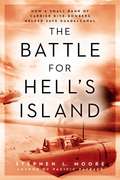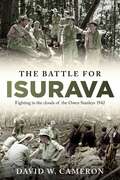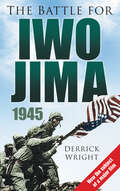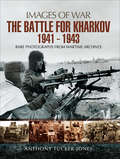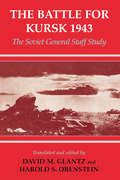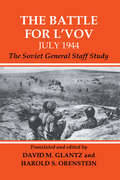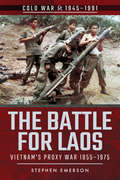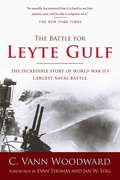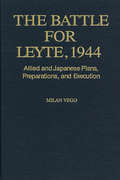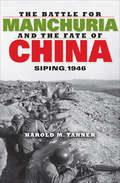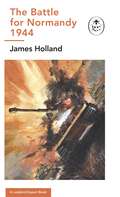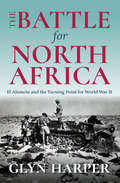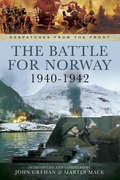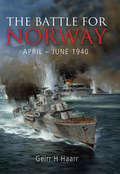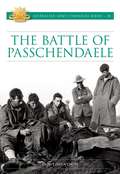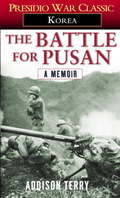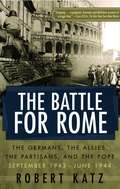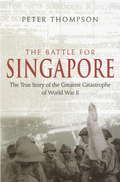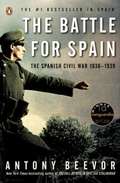- Table View
- List View
The Battle for Hell's Island
by Stephen L. MooreFrom the author of Pacific Payback comes the gripping true story of the Cactus Air Force and how this rugged crew of Dive-Bombers helped save Guadalcanal and won the war.November 1942: Japanese and American forces have been fighting for control of Guadalcanal, a small but pivotal island in Japan's expansion through the South Pacific. Both sides have endured months of grueling battle under the worst circumstances: hellish jungles, meager rations, and tropical diseases, which have taken a severe mental and physical toll on the combatants. The Japanese call Guadalcanal Jigoku no Jima--Hell's Island.Amid a seeming stalemate, a small group of U.S. Navy dive bombers are called upon to help determine the island's fate. The men have until recently been serving in their respective squadrons aboard the USS Lexington and the USS Yorktown, fighting in the thick of the Pacific War's aerial battles. Their skills have been honed to a fine edge, even as injury and death inexorably have depleted their ranks. When their carriers are lost, many of the men end up on the USS Enterprise. Battle damage to that carrier then forces them from their home at sea to operating from Henderson Field, a small dirt-and-gravel airstrip on Guadalcanal.With some Marine and Army Air Force planes, they help form the Cactus Air Force, a motley assemblage of fliers tasked with holding the line while making dangerous flights from their jungle airfield. Pounded by daily Japanese air assaults, nightly warship bombardments, and sniper attacks from the jungle, pilots and gunners rarely last more than a few weeks before succumbing to tropical ailments, injury, exhaustion, and death. But when the Japanese launch a final offensive to take the island once and for all, these dive-bomber jocks answer the call of duty--and try to perform miracles in turning back an enemy warship armada, a host of fighter planes, and a convoy of troop transports.A remarkable story of grit, guts, and heroism, The Battle for Hell's Island reveals how command of the South Pacific, and the outcome of the Pacific War, depended on control of a single dirt airstrip--and the small group of battle-weary aviators sent to protect it with their lives.
The Battle for Hell's Island: How a Small Band of Carrier Dive-Bombers Helped Save Guadalcanal
by Stephen L. MooreFrom the author of Pacific Payback comes the gripping true story of the Cactus Air Force and how this rugged crew of Dive-Bombers helped save Guadalcanal and won the war.November 1942: Japanese and American forces have been fighting for control of Guadalcanal, a small but pivotal island in Japan's expansion through the South Pacific. Both sides have endured months of grueling battle under the worst circumstances: hellish jungles, meager rations, and tropical diseases, which have taken a severe mental and physical toll on the combatants. The Japanese call Guadalcanal Jigoku no Jima--Hell's Island.Amid a seeming stalemate, a small group of U.S. Navy dive bombers are called upon to help determine the island's fate. The men have until recently been serving in their respective squadrons aboard the USS Lexington and the USS Yorktown, fighting in the thick of the Pacific War's aerial battles. Their skills have been honed to a fine edge, even as injury and death inexorably have depleted their ranks. When their carriers are lost, many of the men end up on the USS Enterprise. Battle damage to that carrier then forces them from their home at sea to operating from Henderson Field, a small dirt-and-gravel airstrip on Guadalcanal.With some Marine and Army Air Force planes, they help form the Cactus Air Force, a motley assemblage of fliers tasked with holding the line while making dangerous flights from their jungle airfield. Pounded by daily Japanese air assaults, nightly warship bombardments, and sniper attacks from the jungle, pilots and gunners rarely last more than a few weeks before succumbing to tropical ailments, injury, exhaustion, and death. But when the Japanese launch a final offensive to take the island once and for all, these dive-bomber jocks answer the call of duty--and try to perform miracles in turning back an enemy warship armada, a host of fighter planes, and a convoy of troop transports.A remarkable story of grit, guts, and heroism, The Battle for Hell's Island reveals how command of the South Pacific, and the outcome of the Pacific War, depended on control of a single dirt airstrip--and the small group of battle-weary aviators sent to protect it with their lives.
The Battle for Isurava: Fighting in the clouds of the Owen Stanley 1942
by David W. CameronWithin 24 hours of the Japanese invasion of northern New Guinea at Gona in July 1942, the Australian militiamen of &‘B&’ Company, 39th Battalion, spent four weeks fighting a delaying action against a crack Japanese force outnumbered by three to one. By mid-August, the rest of the battalion had arrived, and these men took up a position at Isurava, in the heart of the cloud covered mountains and jungles of the Owen Stanley Range. At Isurava, this small militia force of the 39th Battalion now numbering around 300 men was determined to make a stand against a crack Japanese force of the 144th Regiment and supporting elements, numbering at least 1500. Then on the day the Japanese launched their attack, to the great relief of these militiamen, reinforcements from the 2nd AIF who had fought with great distinction in the Middle East began to arrive in the afternoon having spent days struggling up the track from Port Moresby. Even so, the Australians were still outnumbered, as the Japanese also received reinforcements, and unlike the Japanese, the Australians had no supporting artillery or medium machineguns. The battle for Isurava would be the defining battle of the Kokoda Campaign and has rightfully been described as Australia&’s Thermopylae. It was here that Australia&’s first Victoria Cross in the Pacific war was awarded when the Japanese conducted several ferocious attacks against the Australian perimetre. Private Bruce Kingsbury led an Australian counterattack, rushing forward sweeping the Japanese positions with his Bren gun, saving he situation when all seemed lost — he was killed leading the charge. Another two men were also nominated for the VC during the fighting at Isurava. The outnumbered and poorly equipped Australians managed to hold back the Japanese advance for almost a week; only then did these battle scared and weary men begin a month long fighting withdraw towards Ioribaiwa Ridge just north of Port Morsby. However, their sacrifice provided time for the Australian 25th Brigade to be brought forward — finally forcing the Japanese to withdrawal just as they glimpsed the lights of Port Morseby.
The Battle for Iwo Jima (Cornerstones of Freedom)
by Tom McgowenRelates the events preceding, during, and after the battle for the tiny Japanese island of Iwo Jima, where American victory hastened the end of World War II.
The Battle for Iwo Jima 1945
by Derrick WrightIwo Jima was the United States Marine Corps' toughest ever battle and a turning point in the Pacific War. In February 1945, three Marine Divisions stormed the island's shores in what was supposed to be a ten-day battle, but they had reckoned without General Tadamichi Kuribayashi, the enemy commander.
The Battle for Kharkov, 1941–1943 (Images of War)
by Anthony Tucker-JonesA pictorial history of a series of World War II battles between the Soviet Red Army and the Nazi Wehrmacht around a city in present-day Ukraine. The four battles fought for Kharkov during the Second World War are often overshadowed by the battles for Moscow, Leningrad, and Stalingrad, yet they were critical stages in the struggle between the Wehrmacht and the Red Army for control of the southern Soviet Union. Anthony Tucker-Jones, in this volume in the Images of War series, offers a visual record of the dramatic and bloody conflict that took place there, showing every grim aspect of the fighting. Kharkov became one of the most bitterly contested cities during the war on the Eastern Front, and this book presents a graphic overview of the atrocious conditions the soldiers on both sides had to endure. In 1941 Kharkov fell to Hitler&’s Army Group South. In 1942 the Soviets tried and failed to retake it, losing 240,000 men in the Barvenkovo Bulge. Then, in 1943, the control of the battered city changed hands twice before the Soviets liberated it for good. The fate of Kharkov during the war reflects the history of the wider struggle between Hitler&’s Germany and Stalin&’s Soviet Union.Praise for Battle for Kharkov&“The collection of original un-published Scott Pick photos are exceptional with such quality and topic coverage that the material visually jumps off the pages. . . . Presents a hard hitting and furious review of the period. . . . The ability of the author to cover the lengthy period in a concise review is very solid, and creates a substantial quality of information versus time of reading commitment.&” —Richard Wade, military historian
The Battle for Kursk, 1943: The Soviet General Staff Study (Soviet (Russian) Study of War)
by DAVID M. GLANTZ; HAROLD S. ORENSTEINThis volume offers detailed information about the Red Army's preparation for and conduct of the Battle of Kursk, the nature of the war on the German Eastern Front, and on the range of horrors that have characterized warfare in the 20th century.
The Battle for L'vov July 1944: The Soviet General Staff Study (Soviet (Russian) Study of War #No. 13)
by Harold S. Orenstein David M. GlantzThe Red Army's summer offensive of 1944 against Hitler's Wehrmacht was unprecedented in terms of its scale, scope, and strategic intent and impact. This study details how the Red Army accomplished this feat in the words of those individuals who planned and orchestrated the offensive.
The Battle for Laos: Vietnam's Proxy War, 1955–1975 (Cold War, 1945–1991)
by Stephen EmersonA history of the &“secret war&” in Southeast Asia in which nearly three million tons of bombs decimated a newly independent nation. By 1959 the newly independent Kingdom of Laos was transforming into a Cold War battleground for global superpower competition, having been born out of the chaos following the French military defeat and withdrawal from Indochina in 1954. The country was soon engulfed in a rapidly evolving civil war as rival forces jockeyed for power and swelling foreign intervention intensified the fighting. Adding even more fuel to the fire, &“neutral&” Laos&’s geographic entanglement in the war in neighboring South Vietnam deepened in the early 1960s as Hanoi&’s reliance on the Ho Chi Minh Trail for moving men and matériel through the southern Laotian panhandle grew exponentially, making it a priority target of American interdiction efforts. For almost twenty years, the fighting between the Western-supported Royal Lao government and the communist-supported Pathet Lao would rage across the plains, jungles, and mountaintops largely unseen by most of the world. Thousands on each side would die and many more would be displaced as the conflict on the ground ebbed and flowed from season to season and year to year. And in the skies above, American and Royal Laotian aircraft would rain down their deadly payloads, decimating large swaths of the countryside in pursuit of victory. Nearly three million tons of bombs would be dropped on Laotian territory between 1965 and 1973, leaving a legacy of unexploded ordnance that lingers to this day. The battle for Laos is a tale of entire communities and generations caught up in a war seemingly without end, one that pitted competing foreign interests and their proxies against each other and was forever tied to Washington&’s pursuit of victory in Vietnam. This book tells the story of this so-called &“secret war.&”
The Battle for Laos: Vietnam's Proxy War, 1955–1975 (Cold War, 1945–1991)
by Stephen EmersonA history of the &“secret war&” in Southeast Asia in which nearly three million tons of bombs decimated a newly independent nation. By 1959 the newly independent Kingdom of Laos was transforming into a Cold War battleground for global superpower competition, having been born out of the chaos following the French military defeat and withdrawal from Indochina in 1954. The country was soon engulfed in a rapidly evolving civil war as rival forces jockeyed for power and swelling foreign intervention intensified the fighting. Adding even more fuel to the fire, &“neutral&” Laos&’s geographic entanglement in the war in neighboring South Vietnam deepened in the early 1960s as Hanoi&’s reliance on the Ho Chi Minh Trail for moving men and matériel through the southern Laotian panhandle grew exponentially, making it a priority target of American interdiction efforts. For almost twenty years, the fighting between the Western-supported Royal Lao government and the communist-supported Pathet Lao would rage across the plains, jungles, and mountaintops largely unseen by most of the world. Thousands on each side would die and many more would be displaced as the conflict on the ground ebbed and flowed from season to season and year to year. And in the skies above, American and Royal Laotian aircraft would rain down their deadly payloads, decimating large swaths of the countryside in pursuit of victory. Nearly three million tons of bombs would be dropped on Laotian territory between 1965 and 1973, leaving a legacy of unexploded ordnance that lingers to this day. The battle for Laos is a tale of entire communities and generations caught up in a war seemingly without end, one that pitted competing foreign interests and their proxies against each other and was forever tied to Washington&’s pursuit of victory in Vietnam. This book tells the story of this so-called &“secret war.&”
The Battle for Leyte Gulf: The Incredible Story of World War II's Largest Naval Battle
by Evan Thomas C. Vann WoodwardPulitzer-Prize-winner and bestselling author C. Vann Woodward recreates the gripping account of the battle for Leyte Gulf--the greatest naval battle of World War II and the largest engagement ever fought on the high seas. For the Japanese, it represented their supreme effort; they committed to action virtually every operational fighting ship on the lists of the Imperial Navy, including two powerful new battleships of the Yamato class. It also ended in their greatest defeat--and a tremendous victory for the United States Navy. Features a new introduction by Evan Thomas, author of Sea of Thunder.
The Battle for Leyte, 1944
by Milan VegoOne of the largest and most complex military efforts ever undertaken, the Leyte Operation was the Allies' first and most important major combined operation to liberate the Philippine archipelago. The stakes were high: a successful landing at Leyte was critical to a subsequent assault on Luzon and total control of the Philippines. If Japan lost the Philippines, its supply of oil and other strategic raw materials would be cut off and its Navy doomed to an inglorious end. In this comprehensive study, one of the world's leading authorities on the subject addresses all aspects of the two-month-long ground, sea, and air invasion, and presents a complete evaluation of theater-wide command, organization, intelligence, and logistics.Drawing on a wealth of Allied and Japanese primary documents and countless secondary sources, Milan Vego describes and analyzes the operational planning and preparation as well as the execution of actions on both sides. Focusing on the operational versus tactical aspects of the struggle, he critically assesses the major decisions made by the senior commanders. His access to the Allied Magic radio intercepts allows him to shed light on what Allied and Japanese commanders knew and did not know about each other. Unlike other books on the subject, Vego draws conclusions and provides operational lessons learned based on his conclusions. A large number of maps, figures, and tables enhance the text.
The Battle for Manchuria and the Fate of China: Siping, 1946 (Twentieth-Century Battles)
by Harold M. Tanner&“A well-organized and excellently researched work&” (H-War) on one of the crucial battles of China&’s civil war. In the spring of 1946, Communists and Nationalist Chinese were battled for control of Manchuria and supremacy in the civil war. The Nationalist attack on Siping ended with a Communist withdrawal, but further pursuit was halted by a ceasefire brokered by the American general, George Marshall. Within three years, Mao Zedong&’s troops had captured Manchuria and would soon drive Chiang Kai-shek&’s forces off the mainland. Did Marshall, as Chiang later claimed, save the Communists and determine China&’s fate? Putting the battle into the context of the military and political struggles fought, Harold M. Tanner casts light on all sides of this historic confrontation and shows how the outcome has been, and continues to be, interpreted to suit the needs of competing visions of China&’s past and future. &“A genuine addition to our knowledge about this battle and the Chinese civil war in general.&” —Mark Wilkinson, Virginia Military Institute
The Battle for Moscow
by David StahelIn November 1941 Hitler ordered German forces to complete the final drive on the Soviet capital, now less than 100 kilometres away. Army Group Centre was pressed into the attack for one last attempt to break Soviet resistance before the onset of winter. From the German perspective the final drive on Moscow had all the ingredients of a dramatic final battle in the east, which, according to previous accounts, only failed at the gates of Moscow. David Stahel now challenges this well-established narrative by demonstrating that the last German offensive of 1941 was a forlorn effort, undermined by operational weakness and poor logistics, and driven forward by what he identifies as National Socialist military thinking. With unparalleled research from previously undocumented army files and soldiers' letters, Stahel takes a fresh look at the battle for Moscow, which even before the Soviet winter offensive, threatened disaster for Germany's war in the east.
The Battle for Moscow: Riveting Story of the Most Bloody and Barbaric Battle of World War II
by Albert SeatonThe course of human civilization has turned on the outcome of a select few climactic battles throughout history, but never more so than when Stalin's enigmatic Soviet Union desperately rallied its resources to stave off Hitler's armies in the Battle for Moscow. From the drama in the command posts to the plight of the infantry and armor in the mud and snow, Seaton illuminates the titanic struggle that was the pivotal battle of WWII.
The Battle for Normandy, 1944: (WW2 #9) (The Ladybird Expert Series #15)
by James HollandBOOK 9 OF THE LADYBIRD EXPERT HISTORY OF THE SECOND WORLD WAR, FROM AWARD-WINNING HISTORIAN JAMES HOLLANDFeaturing stunning illustrations from Keith Burns, bringing the story to life in vivid detailWhy did the Allies attack on D-Day?How did the Allies pick Normandy as a target?What was Operation Overload, the second front against the Nazis?JUNE 6 1944D-Day was a deciding conflict in World War II. But the invasion was not a straightforward attack.From feeding Nazi spies false information on the attack, to developing new technology like the Mulberry harbours, D-Day changed the course of the War for good.THE LARGEST SEABORNE INVASION IN HISTORYWritten by historian, author and broadcaster James Holland, The Battle for Normandy is an essential introduction to the naval invasion that began the liberation of Western Europe from the Nazis.__________Discover the full Ladybird Expert WW2 series:BlitzkriegThe Battle of BritainBattle of the AtlanticThe Desert WarThe Eastern FrontThe Pacific WarThe Bomber WarThe War in ItalyThe Battle for NormandyThe War in BurmaVictory in EuropeVictory Against Japan
The Battle for North Africa: El Alamein and the Turning Point for World War II (Twentieth-Century Battles)
by Glyn Harper&“A well-researched and highly readable account of one of World War II&’s most important &‘turning point&’ battles.&” —Jerry D. Morelock, Senior Editor at HistoryNet.com In the early years of World War II, Germany shocked the world with a devastating blitzkrieg, rapidly conquered most of Europe, and pushed into North Africa. As the Allies scrambled to counter the Axis armies, the British Eighth Army confronted the experienced Afrika Corps, led by German field marshal Erwin Rommel, in three battles at El Alamein. In the first battle, the Eighth Army narrowly halted the advance of the Germans during the summer of 1942. However, the stalemate left Nazi troops within striking distance of the Suez Canal, which would provide a critical tactical advantage to the controlling force. War historian Glyn Harper dives into the story, vividly narrating the events, strategies, and personalities surrounding the battles and paying particular attention to the Second Battle of El Alamein, a crucial turning point in the war that would be described by Winston Churchill as &“the end of the beginning.&” Moving beyond a simple narrative of the conflict, The Battle for North Africa tackles critical themes, such as the problems of coalition warfare, the use of military intelligence, the role of celebrity generals, and the importance of an all-arms approach to modern warfare.
The Battle for Norway, 1940–1942 (Despatches From The Front)
by Martin Mace John GrehanDespatches in this volume include that on the first and second battles of Narvik in 1940; the despatch on operations in central Norway 1940, by Lieutenant General H.R.S. Massy, Commander-in-Chief, North West Expeditionary Force; Despatch on operations in Northern Norway between April and June 1940; the despatch on carrier-borne aircraft attacks on Kirkenes (Norway) and Petsamo (Finland) in 1941, by Admiral Sir John C. Tovey; the despatch on the raid on military and economic objectives in the Lofoten Islands (Norway) in March 1941, by Admiral Sir John C. Tovey, Commander-in-Chief, Home Fleet; and the despatch on the raid on military and economic objectives in the vicinity of Vaagso Island (Norway) in December 1941, by Admiral Sir John C. Tovey.This unique collection of original documents will prove to be an invaluable resource for historians, students and all those interested in what was one of the most significant periods in British military history.
The Battle for Norway: April–June 1940
by Geirr HaarrThe acclaimed historian and author of The Gathering Storm continues his in-depth study of Northern European naval warfare during WWII. The Nazi invasion of Norway in 1940 was the first modern campaign in which sea, air and ground forces interacted decisively. In this detailed history, Gierr H. Haarr presents a comprehensive study of the naval aspects of the operation. He begins with the events off the coast of southern and western Norway where Norwegian and British forces attempted to halt the German advance out of the invasion ports as well as the stream of supplies and reinforcements across the Skagerrak Strait. Haarr then focuses on the British landings in Central Norway, where the Royal Navy first had its mastery challenged by air superiority from land-based aircraft. Next, he examines the events in and around Narvik where Allied naval, air and land forces were engaged in the first combined amphibious landings of World War II. Finally, Haarr sums up the the evacuation in June, in which the first carrier task force operations of the war, including the loss of the HMS Glorious, figure prominently. As Haarr&’s previous volume, The Gathering Storm, the narration shifts between strategic and operational issues, and the experiences of the officers and soldiers on the frontlines. Extensive research and use of primary sources reveal the many sides of this battle, some of which remain controversial to this day.
The Battle for Passchendaele: Australian Army Campaigns Series 28 (Australian Army Campaigns Series #28)
by Ian FinlaysonThe Battle for Passchendaele on 12 October 1917 was one of the epic struggles of the First World War. British Field Marshal Douglas Haig allocated II ANZAC Corps to capture Passchendaele village, with Major General Monash&’s 3rd Australian Division and the New Zealand Division leading the attack. For both divisions the battle was a bloody debacle. Monash&’s division started the battle with 5800 men and, just 24 hours later, could only muster 2600, suffering horrendous losses for a small territorial gain which was later relinquished. The New Zealand Division was trapped in front of the German wire and barely moved from its start line, suffering one of its highest casualty rates of the war. Fought in conditions which seemed to preclude any chance of success, the battle has become a metaphor for pointless sacrifice. After the battle the British and Australian leadership were unanimous in placing blame for the defeat on the all-pervasive mud. Monash, writing to his wife, believed that his plan &‘would have succeeded in normal conditions&’. Yet, two weeks later, in similar weather and terrain, Lieutenant General Currie&’s Canadian Corps succeeded where Monash and Godley&’s II ANZAC Corps did not. The central focus of this book is a detailed analysis of the 3rd Australian Division&’s plan and execution of the attack on Passchendaele. By examining the differences between the Australian and Canadian plans for the capture of Passchendaele, the author casts this iconic battle in a completely different light. It is a re-examination that is long overdue.
The Battle for Pusan
by Addison TerryIn 1950, North Korean Army forces shocked the world as they streamed across the 38th Parallel in the opening attack of a campaign to unite the peninsula by forces of arms under the communist regime in Pyongyang. Hastily thrown into battle, US forces finally stabilized a defensive perimeter around the south port city of Pusan. But could they hold it?
The Battle for Quebec 1759: Britain's Conquest of Canada
by Matthew C WardA concise and readable history of the British war against the French for control of Canada.
The Battle for Rome: The Germans, the Allies, the Partisans, and the Pope, September 1943 - June 1944
by Robert KatzIn September 1943, the German army marched into Rome, beginning an occupation that would last nine months until Allied forces liberated the ancient city. During those 270 days, clashing factions -- the occupying Germans, the Allies, the growing resistance movement, and the Pope -- contended for control over the destiny of the Eternal City. In The Battle for Rome, Robert Katz vividly recreates the drama of the occupation and offers new information from recently declassified documents to explain the intentions of the rival forces. One of the enduring myths of World War II is the legend that Rome was an "open city," free from military activity. In fact the German occupation was brutal, beginning almost immediately with the first roundup of Jews in Italy. Rome was a strategic prize that the Germans and the Allies fought bitterly to win. The Allied advance up the Italian peninsula from Salerno and Anzio in some of the bloodiest fighting of the war was designed to capture the Italian capital. Dominating the city in his own way was Pope Pius XII, who used his authority in a ceaseless effort to spare Rome, especially the Vatican and the papal properties, from destruction. But historical documents demonstrate that the Pope was as concerned about the Partisans as he was about the Nazis, regarding the Partisans as harbingers of Communism in the Eternal City. The Roman Resistance was a coalition of political parties that agreed on little beyond liberating Rome, but the Partisans, the organized military arm of the coalition, became increasingly active and effective as the occupation lengthened. Katz tells the story of two young Partisans, Elena and Paolo, who fought side by side, became lovers, and later played a central role in the most significant guerrilla action of the occupation. In retaliation for this action, the Germans committed the Ardeatine Caves Massacre, slaying hundreds of Roman men and boys. The Pope's decision not to intervene in that atrocity has been a source of controversy and debate among historians for decades, but drawing on Vatican documents, Katz authoritatively examines the matter. Katz takes readers into the occupied city to witness the desperate efforts of the key actors: OSS undercover agent Peter Tompkins, struggling to forge an effective spy network among the Partisans; German diplomats, working against their own government to save Rome even as they condoned the Nazi repression of its citizens; Pope Pius XII, anxiously trying to protect the Vatican at the risk of depending on the occupying Germans, who maintained order by increasingly draconian measures; and the U.S. and British commanders, who disagreed about the best way to engage the enemy, turning the final advance into a race to be first to take Rome. The Battle for Rome is a landmark work that draws on newly released documents and firsthand testimony gathered over decades to offer the finest account yet of one of the most dramatic episodes of World War II.
The Battle for Singapore: The True Story of the Greatest Catastrophe of World War II
by Peter ThompsonThe true story of the 'the greatest defeat and largest capitulation' in British military history. The Fall of Singapore on 15 February 1942 is a military disaster of enduring fascination. For the 60th anniversary of the liberation of the island, Peter Thompson tells the explosive story of the Malayan campaign, the siege of Singapore, the ignominious surrender to a much smaller Japanese force, and the Japanese occupation through the eyes of those who were there - the soldiers of all nationalities and members of Singapore's beleaguered population. An enthralling and perceptive account, which never loses sight of the human cost of the tragedy - Yorkshire Evening Post. An insightful and dramatic analysis - The Good Book Guide
The Battle for Spain
by Antony BeevorA fresh and acclaimed account of the Spanish Civil War by the bestselling author of Stalingrad and The Fall Of Berlin 1945 To mark the 70th anniversary of the Spanish Civil War's outbreak, Antony Beevor has written a completely updated and revised account of one of the most bitter and hard-fought wars of the twentieth century. With new material gleaned from the Russian archives and numerous other sources, this brisk and accessible book (Spain's #1 bestseller for twelve weeks), provides a balanced and penetrating perspective, explaining the tensions that led to this terrible overture to World War II and affording new insights into the war-its causes, course, and consequences.
